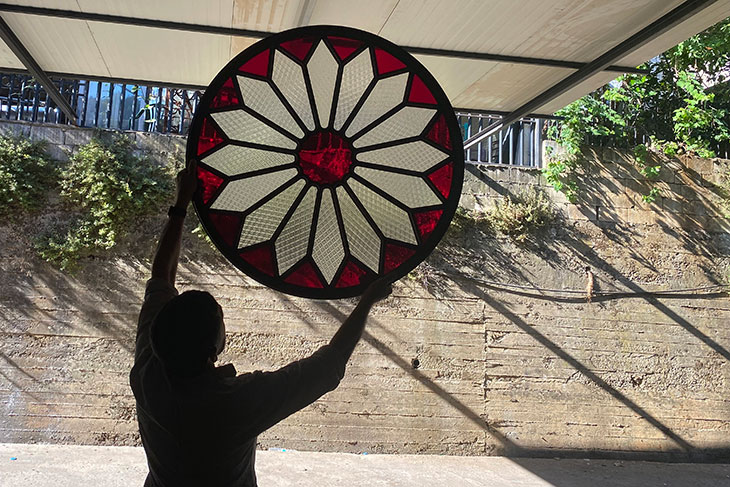One year after the catastrophic blast of 4 August, the port of Beirut and its surroundings are still part of an apocalyptic landscape. The entire city is in limbo. By day, only dirt and misery are visible and by night Beirut is the capital of darkness. Besides the aftermath of the explosion, Lebanon has endured one of the greatest economic collapses of the last 150 years. The Lebanese pound has lost 90 per cent of its value, bank accounts are frozen and the financial system in a country once known as the ‘Switzerland of the Middle East’ is dislocated. Currency rates change so frequently that nobody knows the real price of anything any more. State failure means that there is hardly any electricity – a mere two hours’ worth per day – and a shortage of fuel that limits the activity of power generators and creates monstrous lines in front of petrol stations with waiting times varying from 30 minutes to three hours in the heat. Medicines have vanished from pharmacies and patients who don’t have relatives who can send them from abroad may die from the lack of appropriate treatment. Hospitals, universities, schools and all sort of corporations are on a tightrope; starvation and homelessness are a grim reality.
In this bleak context, any sort of progress looks like a miracle. Thanks to international aid, donations and NGOs, a large number of residential buildings, sometimes entire streets or neighbourhoods have been reconstructed allowing residents to recover their homes. There is still much to be done, however, especially for historic buildings where operations are costly, specialised craftsmanship is required and questions of legal ownership may be involved. Relief organisations such as Beirut Heritage Initiative, Live Love Beirut, Bebw’shebbek and Beit el Baraka sometimes join forces to make progress in particular clusters. For monumental edifices, things are more complicated. At the Sursock-Cochrane Palace, the northern facade facing the port was unstable and could have fallen apart; it has been since been covered and reinforced. A chiselled brass door made by Maison Tarazi in 1915 was repaired and reinstalled by the same firm. The neighbouring Sursock Museum managed to secure a sufficient amount of the funds needed for its reconstruction, and is expected to reopen in spring 2022.
House on Armenia Street, 500 metres from the site of the Port explosion. Photo: Gregory Buchakjian

The recovery of damaged works of art and archaeological items in public and private collections is also underway, with specific pieces being taken care of abroad, such as paintings from Sursock Museum at Centre Pompidou and objects from the Archaeological Museum at the American University of Beirut at the British Museum. A Penitent Magdalene from the Sursock-Cochrane Palace has been displayed, in its wounded state, in ‘Le Signore dell’Arte’ at the Palazzo Reale in Milan. In the exhibition catalogue, Riccardo Lattuada confirmed my attribution of the painting to Artemisia Gentileschi. It is going to stay in Italy to be restored.
In the meantime, the contemporary art scene is also re-emerging. During the winter lockdown, a collective of students from Académie libanaise des beaux-arts (Alba), mounted an exhibition in a destroyed house. In April, gallery owner Annie Fodoulian organised a show called ‘Everyone is the creator of one’s faith’ in a residential building that was devastated on 4 August and is still unrepaired. The title of the show was taken from the last social media status of Fodoulian’s daughter before she was killed by the explosion. Since then, most of the galleries have reopened. Marfa’ Projects, which is adjacent to the port (marfa’ being the word for port), chose the theme of ‘Water’ for its first show when it reopened in May. Galerie Tanit, where many were killed and wounded, has taken up the theme of ‘Togetherness’, putting out an open call for young and emerging artists (until 7 August). Jeanne et Moreau, a photographic duo, contributed with The work of art at the age of economic collapse, a print exchange involving 40 artists. At Sfeir Semler Gallery there is an exhibition of work by Marwan Rechmaoui that also includes sculptures made of debris salvaged from the space, which was severely damaged and has now been rebuilt, after the blast (until 12 August).
2021-expo-collective Exhibition of the ‘Bala Manyaké’ collective of students from the Académie libanaise des Beaux-Arts, in a destroyed house in Beirut, 2021. Photo: Gregory Buchakjian

We have also been able to see some extremely powerful exhibitions that are not directly related to the current situation, such as ‘Itinérance’ by Pascale Feghali and Riwa Philipps, based on the archive of the Ayloul Festival, an annual event that ran from 1997–2001 and contributed greatly to the vigour of the art scene of the time. Saleh Barakat, the founder of Agial Art Gallery, is digging into his professional archive in preparation for a retrospective of 30 years of the gallery’s activities. The Arab Image Foundation, which suffered badly in the explosion, has resumed its public programmes. Mina Image Center, which is near the port, has reopened, and so has Beirut Art Center and the National Museum. At the Sursock Museum, meanwhile, the restaurant and store are open and the garden hosts performances and film projections.
As Sisyphean as their predicament may be, the courage and determination of all those involved in the arts and the preservation of heritage is an act of survival that gives hope for a brighter future.
Gregory Buchakjian is a visual artist and art historian and director of the School of Visual Arts at Académie Libanaise des Beaux-Arts (ALBA), at the University of Balamand.



